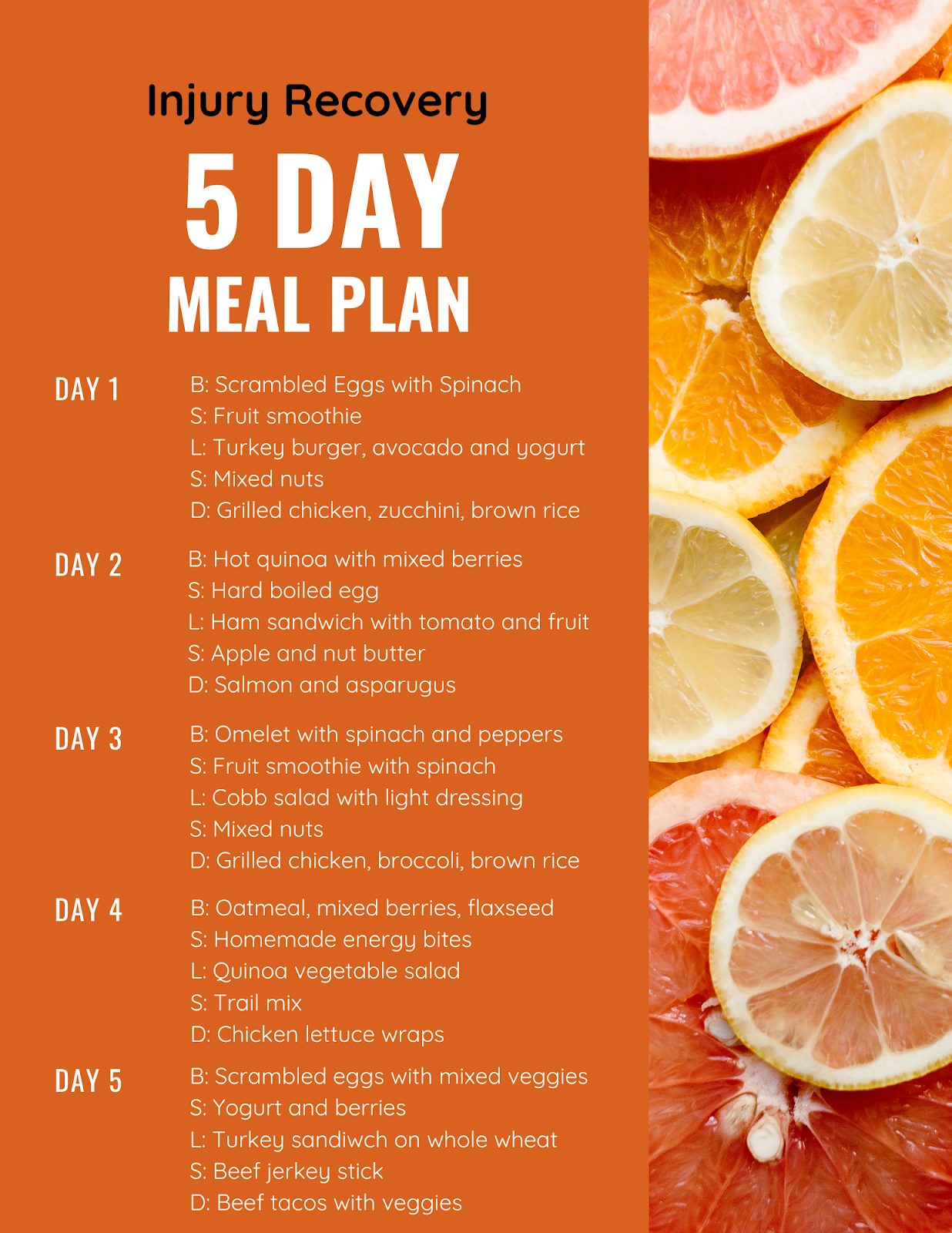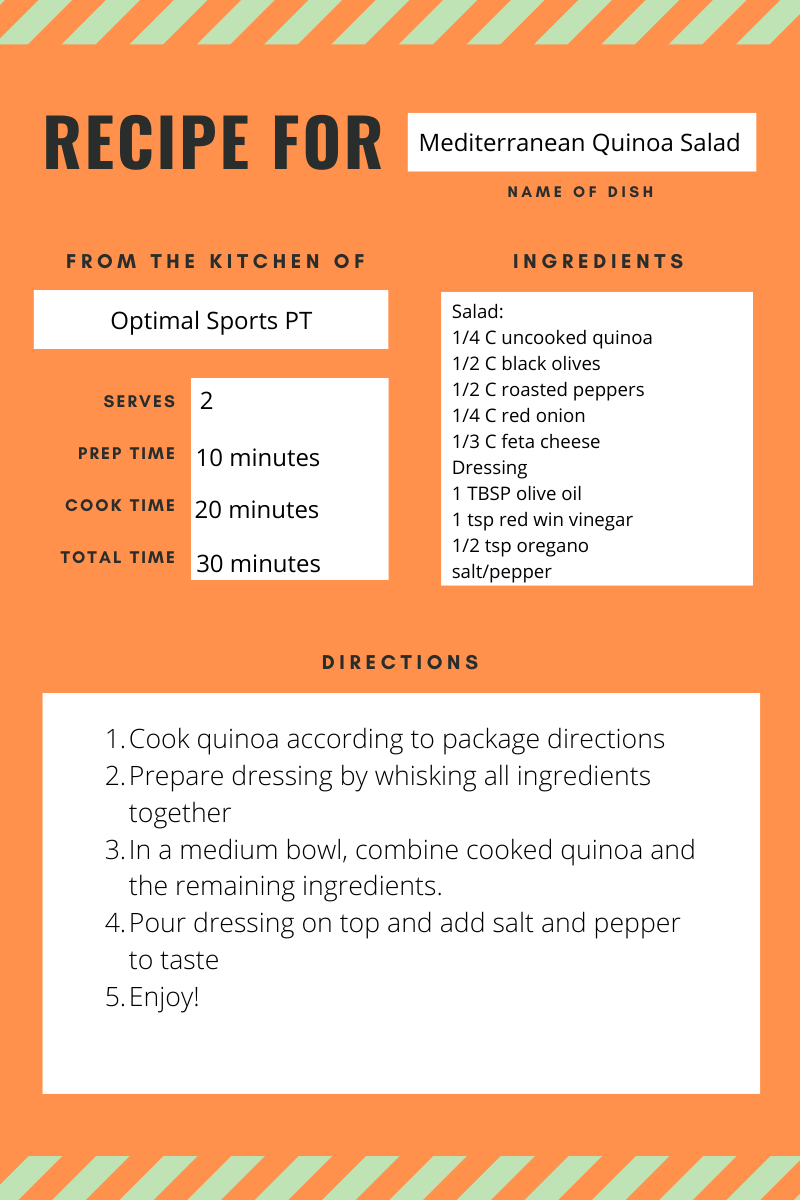Injuries happen. Even to athletes at the top of their game. No one wants to be out of the game longer than necessary. Hard work at the gym, with your physical therapist, or at the doctor’s office is just the first step. Including a well-balanced diet with your recovery is beneficial to optimize recovery.
Proper nutrition is critical for an athlete during the season and during recovery. During the season, an athlete might be looking to gain lean muscle, build strength, or run faster. Athletes need a diet that supports the body’s optimal performance. A diet that boosts the body’s development of tissue and muscle strength. A well-balanced diet is even more important after an injury. A balanced diet can decrease recovery time and make getting back into the game easier.
It’s a common misconception that when injured an athlete should reduce the number of calories. However, when injured, the body’s energy expenditure can increase by as much as 15 – 50% above normal. If an athlete reduces their caloric intake, it’s possible to leave the body at a deficit. A deficit causes critical tissues and bone healing to take longer than anticipated. For example, if an injury requires an athlete to use crutches, they will be burning more calories than walking normally. Instead of reducing calories, an injured athlete should focus on building a diet that best supports recovery.
Athletes can boost their body’s natural healing by leveraging a well-balanced diet made up of real foods. No extra supplements required. Learn more about the four areas of a well-balanced diet that support injury recovery. Also, enjoy a tasty recipe and meal plan to get you started on developing the optimal diet for your recovery.
Protein
Protein is a key ingredient for the body when working to heal. Protein is used to build tissue, muscle being one of them. It’s not uncommon after an injury for an athlete to be immobilized. Immobilization limits the use of the muscles in an affected area. Muscle loss is a common side effect of immobilization because with muscle – you use it or you lose it.
To minimize expected muscle loss after an injury focus on a protein-rich diet. A protein-rich diet will also help to build muscle once normal activity resumes. Research indicates that spreading protein intake throughout the day allows for a slow and steady absorption by the body. Include protein at each meal and in two snacks per day. A protein-rich bedtime snack can even help foster muscle development while you sleep.
To support tissue and muscle development consider adding these protein-rich foods to your diet: meat and poultry, fish, eggs, beans, peas, nuts or seeds.
Tip: Don’t love eggs for breakfast? Try hot Quinoa for a protein-packed alternative.
Healthy Fats
After an injury, a greasy burger or a sweet treat might be just what you’re craving. But, the saturated fats and trans fats found in foods like burgers, hot dogs, lunch meat, or sweets can cause increased inflammation in the body.
Inflammation is a normal part of recovery. Especially in the early stages immediately after injury. Many foods can help to naturally reduce inflammation in the body. Foods high in Omega-3 fatty acids have shown to help reduce inflammation. Foods like olive oil, ground flax, avocado, salmon, and some seeds or nuts are considered anti-inflammatory foods. By limiting or removing pro-inflammatory foods from an athlete’s diet, inflammation and pain can be better managed during injury recovery.
Tip: Want to naturally boost your Omegas? Try adding avocado to a sandwich or a tablespoon of ground flaxseed to your Quinoa breakfast bowl.
Fruits and Veggies
It’s likely that you’ve heard the term ‘eat the rainbow’. Eating the rainbow refers to eating a wide variety of colorful foods. During recovery from an injury eating the rainbow supplies your body with vitamins and minerals required to support the body in healing. This includes Vitamin C, Vitamin D, Magnesium, Silicon, and Vitamin K to name a few. Most of these vitamins and minerals are easily found in fruits and vegetables with minimal supplements required.
Vitamin C helps to create proteins in the body used for tendon and ligament repair. Fruits and vegetables like citrus, bell peppers, leafy greens, broccoli, berries, and tomatoes are great sources of vitamin C.
Vitamin D is one of the hardest vitamins to ingest naturally through food. But, it’s critical for the body’s absorption of Calcium which boosts bone strength. Vitamin D is in leafy greens and broccoli. But, getting some sun exposure or a Vitamin D supplement may be required.
Magnesium, Silicon, and Vitamin K are also important to the development of tissue and bone. Foods like carrots, green beans, and leafy greens help to boost these critical vitamins and minerals.
Tip: Ready for a snack? Try an apple with nut butter. Protein, healthy fats, Vitamin C, and fiber all in one easy snack.
Carbs
Carbohydrates help to support a well-balanced diet and should not be eliminated. Yes, carbs can be your friend. During recovery, less quick burning fuel is required for the body. Because carbs are burned quickly by the body, fewer carbs are required during recovery. Instead, focus on whole grains, oats or quinoa that the body burns more slowly. Slow-burning carbs will keep you feeling full. Refined sugars found in foods like white rice or white bread can increase inflammation and should be avoided.
Tip: Are you feeling extra hungry during recovery? Limit your carbs and increase your protein so you feel fuller longer. Still want a carb? Try a turkey and avocado sandwich on whole wheat bread. Protein, carb, and a healthy fat.
Planning meals that best support your recovery can be challenging. It is beneficial to plan ahead to have great options available. Before making any diet changes, discuss the changes with your physician. Also, ensure you adjust meal plans to account for any allergies or food sensitivities. Review this one-week example meal plan as a starting point.

Are you ready to hack the healing process and take your injury recovery to the next level? Start by focusing on a well-balanced diet. A diet high in protein, healthy fats, fruits, vegetables, and carbs. No restrictions. No eliminations. Just a wide variety of whole foods.
A well-balanced diet will help control inflammation, support rebuilding injured tissue, and minimize muscle loss. All while helping to support strength preservation to get you back in the game.
Review your diet with an Optimal Sports Physical Therapist today. Learn how you might be able to take your recovery to the next level. Call our office today to schedule a visit at (406) 502-1782.

Metadata: Injuries happen. Even to the best athletes. Incorporating four easy and nutritional items to your diet during injury recovery can help control inflammation, support healing tissue and muscle development, and get you back in the game.
